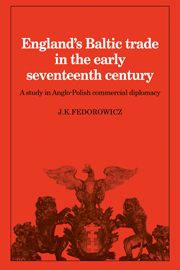 England's Baltic Trade in the Early Seventeenth Century
England's Baltic Trade in the Early Seventeenth Century Book contents
- Frontmatter
- Contents
- Preface
- List of maps and graphs
- List of abbreviations
- Map
- Introduction
- 1 English perceptions of the Polish Commonwealth
- 2 The mechanics of English diplomacy in the Eastland
- 3 The early history of the Eastland Staple at Elbing
- 4 The operation of the staple
- 5 The pattern of English shipping into the Baltic
- 6 English exports to the Baltic
- 7 English imports from the Baltic
- 8 The threat to the Eastland Staple at Elbing
- 9 The depression of 1620 and the crisis of England's Baltic trade
- 10 The political crisis, 1620–9
- 11 The mission of Sir Thomas Roe to the Eastland
- 12 Attempts at reconciliation with Danzig, 1630–5
- 13 The climax of English commercial diplomacy, 1635–42
- 14 Conclusion
- Notes
- Bibliography
- Index
4 - The operation of the staple
Published online by Cambridge University Press: 05 November 2011
- Frontmatter
- Contents
- Preface
- List of maps and graphs
- List of abbreviations
- Map
- Introduction
- 1 English perceptions of the Polish Commonwealth
- 2 The mechanics of English diplomacy in the Eastland
- 3 The early history of the Eastland Staple at Elbing
- 4 The operation of the staple
- 5 The pattern of English shipping into the Baltic
- 6 English exports to the Baltic
- 7 English imports from the Baltic
- 8 The threat to the Eastland Staple at Elbing
- 9 The depression of 1620 and the crisis of England's Baltic trade
- 10 The political crisis, 1620–9
- 11 The mission of Sir Thomas Roe to the Eastland
- 12 Attempts at reconciliation with Danzig, 1630–5
- 13 The climax of English commercial diplomacy, 1635–42
- 14 Conclusion
- Notes
- Bibliography
- Index
Summary
The significance of England's Polish trade
The substance of England's commercial relationship with Poland is well enough known not to need any elaboration here: in the most general terms it consisted of an exchange of finished English cloths (broadcloth, kersies and some ‘new draperies’) for traditional Polish raw materials, and commodities such as grain, timber, flax, hemp, pitch, tar, ashes, wax and iron. Setting aside for the moment a detailed consideration of the mechanics of this exchange, one should attempt at least a general assessment of its significance and mutual advantages for the two partners.
English broadcloth, known in Polish as lunński and later as falendysz cloth, was extremely popular among the gentry, rich merchants and professional class of Poland from the fifteenth century; only minor and declining competition from the most luxurious grades of Flemish, French or Italian cloth threatened its pre-eminence. Even the cheaper kersies were in considerable demand, though they faced increasing competition from comparable Dutch and Silesian products. Polish demand for English cloth even rose during the sixteenth century as Poland's booming exports earned increasing amounts of foreign specie. Nevertheless, English cloth, which constituted approximately 90 per cent of the value of all English exports to Poland, was never more than a luxury trade, satisfying the demands of fashion for only a small part of the Polish population. It was a trade which could easily be dispensed with in a crisis, particularly since alternative suppliers existed not only in Moravia, Silesia and Holland, but also within Poland itself: both Danzig and Wielkopolska produced significant amounts of lower priced cloth.
- Type
- Chapter
- Information
- England's Baltic Trade in the Early Seventeenth CenturyA Study in Anglo-Polish Commercial Diplomacy, pp. 50 - 72Publisher: Cambridge University PressPrint publication year: 1980


